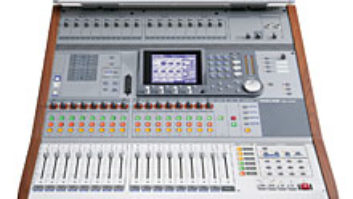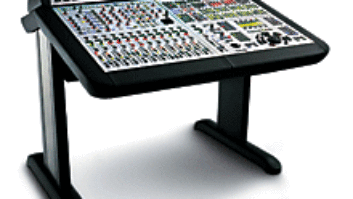Before the 1980s, there was very little cross-pollination between the monitor features of music recording and film re-recording consoles. The former assumed two basic modes: recording to multitrack, followed by a 2-track mixdown, with both modes employing standard stereo monitoring, although a few ’70s music consoles made allowances for “quad” mixing.
Film consoles, on the other hand, are total “mix” creatures and, instead of mic preamps, have elaborate monitoring sections to accommodate the variety of speaker and recording formats. The act of mixing involves punching into multiple “stem” recorders that document the final mix as separate food groups: dialog, music and sound effects. Not only are up to three mixers (as in people) working simultaneously, but they separately have to be able to compare off-tape to console bus, or PEC/direct in film sound parlance. Further complicating film mixes is the presence of surround encoding and decoding devices, which might be needed for monitoring, recording or a combination of both. All of this is clearly beyond the scope of normal stereo mixing.
The first full-featured device to bring the capabilities of film-style monitoring to any multitrack console was Otari’s PicMix, which allowed a maximum of 32 tracks to be matrixed across eight speaker channels. (There are actually 64 inputs, as each track is represented both by the console bus and the recorder return.) PEC/direct switching and track arming of individual tracks (of up to eight groups of tracks) is elegantly handled by a separate console-mounted controller.
PicMix addresses most film sound monitoring needs, yet it has three notable shortcomings: It doesn’t deal gracefully with the five screen channels in the 7.1 format or the three surround channels in surround EX format, especially with regard to downmixing to 5.1 and 4:2:4 (matrix-encoded) playback. Secondly, multiple speaker systems are not accommodated. (While this is the norm for film mixing, it’s unacceptable for television or music multichannel situations.) Finally, bass management is not considered: There is a send to the speakers, and they are left to fend for themselves.
At my facility in New Orleans, Swelltone Labs, we were faced with the first of these issues for the mix of Ocean’s Eleven, which I wanted to do 7.1. The solution lay in our purchasing the Martinsound MultiMAX EX monitor controller that specifically addresses PicMix’s shortcomings, and we now use both units in series, with the PicMix handling 32×8 matrixing and allowing us to mute and solo specific output groups. The insert send goes to the MultiMAX, which then controls the downmixing and surround encode/decode processing before sending the signal to the speakers.
This combination of devices works quite well in our current situation, yet they are both lacking in one key, simple feature: the inputs, outputs and insert points are analog only. (Note: These aren’t the only monitor matrices manufactured; merely the ones I’m most familiar with.) Anyone using digital consoles or workstations has to enter the analog world earlier than should be necessary — that is, before the send to the B-chain (equalizers, cross-overs, amps and speakers).
ENTER THE DS-M7.1
Last year, Tascam introduced a digital monitor matrix, the DS-M7.1 Digital Surround Monitor Controller, filling the void in the marketplace and creating a rough digital equivalent of the Martinsound MultiMAX’s downmixing and multichannel monitoring capabilities.
Housed in a three-rackspace chassis (with a removable front panel that doubles as a remote control), the DS-M7.1 adds multispeaker monitoring control to digital consoles that only have eight output buses. The DS-M7.1’s main market is the thousands of music, broadcast, video post and gaming/multimedia studios that need to upgrade for surround production.
The DS-M7.1 is set up to receive eight console buses (either from the stock TDIF connection or via an optional AES or analog I/O card). With the MultiMAX or PicMix, you must mult the analog console outputs to go both to the recorder and to the direct side of the inputs. The DS-M7.1 skirts this issue (for digital consoles and recorders) by allowing the user to send the console outputs to the DS-M7.1, which then distributes them to both a “tracking” recorder and to three flavors of digital “master” recorders: ADAT, TDIF and AES. They are simultaneously connected, with one of their outputs selected as the “return.” The output send to the tracking recorder exists primarily to allow the studio to patch console outputs 1 through 8 to the tracking multitrack while recording, and to the DS-M7.1 during multichannel mixes, without having to repatch in between. (Outputs 9 and above from the console presumably go direct to the multitrack recorder, as they aren’t needed for 5.1 or 7.1-channel mixdowns.)
Since 1998, I have spread the dialog, music and sound effects stems across 32 tracks on most of my larger films, going to less than 16 tracks only a handful of times. The DS-M7.1 does not offer the summing and matrixing of the 24-plus stem channels that are recorded at a final mix these days. One would never expect this feature for the price of four DS-M7.1s, much less a single unit that retails for $1,899. However, there is a need for Tascam — or someone else — to build a digital matrix that would take up to 48 or 64 console outputs (the 32-track barrier is a bit conservative these days), sending them both to the recorder and the “direct” input side, matrixing them across the multichannel speaker assignments. This would eliminate the need for the console’s outputs to use a digital router to get them to the two destinations. The output of this mythical unit would then go to the input of the DS-M7.1, much as we currently feed the MultiMAX from our PicMix at Swelltone today.
The DS-M7.1 has three slots to expand its I/O capabilities, and in the case of the IF-AN/DM analog I/O board inserted into slot 3, provides connections for analog surround encoding/decoding. This setup cleverly allows the user to simultaneously send to both analog encoder/decoders (such as the Dolby SEU-4/SDU-4 units) and to their digital equivalents. Obviously, the DS-M7.1 will accept the return from only one of the decoders. Both the sends and returns to/from the encode/decode inserts are extremely well-designed and flexible. The send is after the direct/playback (“bus/return” in DS-M7.1 terms) switch and can be pre or post the Input Summing Router.
As the DS-M7.1’s insert points are placed in front of the downmix options, there’s no level control of individual channels in the Input Summing Router, only control of which channels go to the insert send in the “post” mode. While the unit is designed to downmix very flexibly from 7.1 and 6.1 to 5.1, L/R stereo and mono, those downmix coefficients can’t apply to the encode/decode insert point. Furthermore, the insertion-enable/disable switch is a knob turn in a menu, rather than an always-accessible switch on the front panel as it should be.
I was glad to see both the DS-M7.1’s analog and digital monitor output connectors; the digital connections are particularly useful when hooked up to a multichannel digital meter bridge. Connecting the Logitek UV71-B in this manner on our mix stage lets us quickly confirm that the level we’re printing is exactly what we’re hearing. Another nice touch? Tascam lets the user place the digital monitor output before downmixing and bass management, in addition to muting and soloing.
I wish the unit had a calibrated pink-noise level. “Calibrated” means different things to different people, but the film industry uses VU metering to obtain its numbers. In this manner, pink noise hovering around -20 dBFS (using VU meter ballistics) should measure 85 dB/c for each primary screen channel. Tascam made no effort in this direction: It intends for the pink to be used for relative channel balance settings, which is just fine for game, multimedia, broadcast and music production, rather than an absolute “film 85,” although this could possibly be added in future software revisions.
Among the more “modern” calibration tweaks offered by the DS-M7.1 is the ability to compensate for speaker delays. While delays for the surround channel have been around since the beginning of stereo mixing (initially applied to the program, and in later years available in cinema processors, such as with Dolby Digital and SDDS), the use with respect to the main front channels is a relatively new approach. The DS-M7.1 offers up to 50 ms of delay in each channel, in 0.1ms steps. (The large amount of delay offered would primarily be of use in setting up surrounds, where 20 ms would be the average for smaller theaters, and 50 ms for the largest.)
Speaking of film sound history, I am thrilled that the DS-M7.1 supports the 7.1 format with five screen channel speakers. A scattered few folks (like yours truly) will take advantage of those features, although most users won’t have any idea of what it’s for.
The most serious omission of the DS-M7.1 that might be of concern to some users is its very limited options for alternate speakers. Its lone ability in this area is having an LR downmix go to the Lc and Rc speaker outputs. This feature is useless in a film studio, which would have left-center and right-center speakers; even in a normal three-speaker configuration, it only offers an additional stereo pair rather than a second multichannel set. In comparison, the (admittedly more expensive) MultiMAX has separate outputs for a second 5.0 set — sharing the same subwoofer — plus stereo near-field and “small mono” speakers. Some users will find this lack of options on the DS-M7.1 disconcerting, to the point of wishing that the unit had cost more in order to include these features.
Overall, the DS-M7.1 functions as intended, and the control panel functions follow a logical and intuitive setup path. The previous comments and reservations notwithstanding, the unit offers an extensive and flexible value in all areas, including bass management. Muting and solo functions, essential parts of any multichannel monitor controller, are very clearly defined.
The removable front-panel controller is connected via up to 60 feet of shielded twisted-pair cable. I give the overall ergonomics of the front panel a high mark, yet its long, flat and thin design, with the cable coming out of the side, might be awkward in some situations. (The more compact footprint of the Martinsound remote is much more practical to either fit on top of or in a console.)
The unit supports sample rates of up to 96 kHz, which is good for most users, although many will wonder why Tascam didn’t go all the way to 192 kHz, considering the amount of gear supporting that rate.
When I first read of DS-M7.1’s capabilities, I guessed that it would sell for a street price of around $3,500. When I heard that the street price was a little more than half that, I was amazed. While its abilities to be used in a film final-mix situation are limited (because of the lack of stem matrixing abilities noted above), I cannot imagine any multichannel edit or mastering room where a DS-M7.1 would be welcome and an essential addition. The one I purchased will be an integral part of my edit room for years to come.
Tascam, 7733 Telegraph Rd., Montebello, CA 90640; 323/726-0303 www.tascam.com.
Larry Blake is Mix‘s film sound editor.



